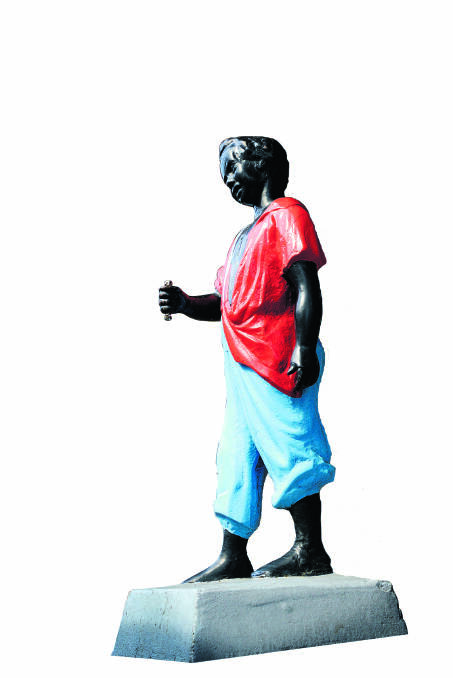He has been a High Street landmark since 1866 and now the legend of Maitland’s black boy is about to become an animated movie.
Subscribe now for unlimited access.
$0/
(min cost $0)
or signup to continue reading
It’s all thanks to decades of research by American author Waymon Lefall who has written a book called Jocko: A Long Way From Home Down Under.
LeFall, who visited here to see the statue in 2009, has long felt a connection to Maitland because of the little black boy, as he is affectionately known.
Maitland’s black boy statue – originally used as a hitching post for horses – is a replica of lawn jockey statues seen in the United States, but he is also a symbol of courage.
He arrived here as a gift to a Maitland tobacconist and there was always a mystery about who the little boy was – until LeFall revealed the statue represents a small African American boy called Jocko Graves.
LeFall’s research showed that during the American revolutionary war, a free black man Tom Graves joined George Washington’s army.
“Graves’ 12-year-old son Jocko wanted to go to war with his father, but he was too young.
“Determined, he went along anyway.
“As General George Washington was preparing to cross the Delaware River for the battle of Trenton, he realised he could not transport the horses by boat and that his steeds would have to be waiting on the other side.
“Jocko volunteered to hold the horses to make sure they were ready when Washington’s troops arrived.
“During the night Jocko froze to death awaiting the soldiers, never letting go of the reins.
“His sacrifice spurred the troops into victory.
“Washington was so touched by the boy’s sacrifice that he erected a statue in Jocko’s honour at Mount Vernon.”
The famous little statue has been standing in several locations in High Street, Maitland for 148 years. He is to thousands of Maitland residents what the Harbour Bridge is to Sydney; the Eiffel Tower is to Paris and the Statue of Liberty is to New York. While the boy is a replica, he still stands in High Street watching the passing parade. He was erected by Friend and Co in 1866 as a hitching post and since that time he has been decorated in many forms to reflect Maitland’s sporting success over the years. He is an obliging little fellow and an important chapter in the history of High Street, Maitland.
- from Jocko A Long Way From Home Down Under by Waymon LeFall
This statue, according to legend, was the precursor to the lawn jockey, Lefall said.
While Jocko’s story has been told many different ways and the details vary, LeFall has never stopped believing in it.
“Lawn jockeys were never a symbol of slavery – they are monuments to a hero,” he said.
There are no records referring to Jocko and there is no statue of a boy at Mount Vernon.
“But this does not mean he did not exist,” Lefall said.
The story came to light in a 1963 children’s book called Jocko: A Legend of the American Revolution by Earl Kroger snr.
A copy of his book is held at the Great Blacks in Wax Museum in Maryland, which also has a wax figure of the frozen child on display.
LeFall vowed to keep the story alive when Kroger died in 1995.
He found a lawn jockey statue in 2000 at a junk yard and used a mould from another to make more of them.
LeFall also wrote a children’s book with two co-authors in 2003.
“This is a true story which was erased from history,” he said.
“Whatever the facts are, there is some truth to every story and there is a moral lesson in every legend.”
The original black boy was taken off High Street, Maitland after a car crash damaged it.
The statue was replaced with a fibreglass replica.


